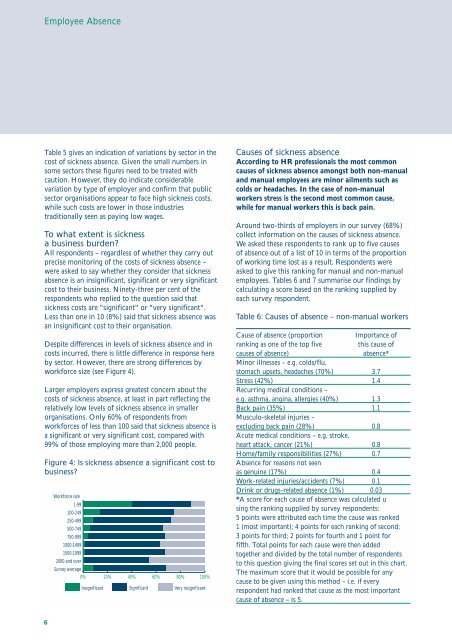Employee Absence - CIPD
Employee Absence - CIPD
Employee Absence - CIPD
- No tags were found...
Create successful ePaper yourself
Turn your PDF publications into a flip-book with our unique Google optimized e-Paper software.
<strong>Employee</strong> <strong>Absence</strong>Table 5 gives an indication of variations by sector in thecost of sickness absence. Given the small numbers insome sectors these figures need to be treated withcaution. However, they do indicate considerablevariation by type of employer and confirm that publicsector organisations appear to face high sickness costs,while such costs are lower in those industriestraditionally seen as paying low wages.To what extent is sicknessa business burden?All respondents – regardless of whether they carry outprecise monitoring of the costs of sickness absence –were asked to say whether they consider that sicknessabsence is an insignificant, significant or very significantcost to their business. Ninety-three per cent of therespondents who replied to the question said thatsickness costs are "significant" or "very significant".Less than one in 10 (8%) said that sickness absence wasan insignificant cost to their organisation.Despite differences in levels of sickness absence and incosts incurred, there is little difference in response hereby sector. However, there are strong differences byworkforce size (see Figure 4).Larger employers express greatest concern about thecosts of sickness absence, at least in part reflecting therelatively low levels of sickness absence in smallerorganisations. Only 60% of respondents fromworkforces of less than 100 said that sickness absence isa significant or very significant cost, compared with99% of those employing more than 2,000 people.Figure 4: Is sickness absence a significant cost tobusiness?Workforce size1-99100-249250-499500-749750-9991000-14991500-19992000 and overSurvey average0% 20% 40% 60% 80% 100%InsignificantSignificantVery insignificantCauses of sickness absenceAccording to HR professionals the most commoncauses of sickness absence amongst both non-manualand manual employees are minor ailments such ascolds or headaches. In the case of non-manualworkers stress is the second most common cause,while for manual workers this is back pain.Around two-thirds of employers in our survey (68%)collect information on the causes of sickness absence.We asked these respondents to rank up to five causesof absence out of a list of 10 in terms of the proportionof working time lost as a result. Respondents wereasked to give this ranking for manual and non-manualemployees. Tables 6 and 7 summarise our findings bycalculating a score based on the ranking supplied byeach survey respondent.Table 6: Causes of absence – non-manual workersCause of absence (proportion Importance ofranking as one of the top fivethis cause ofcauses of absence)absence*Minor illnesses – e.g. colds/flu,stomach upsets, headaches (70%) 3.7Stress (42%) 1.4Recurring medical conditions –e.g. asthma, angina, allergies (40%) 1.3Back pain (35%) 1.1Musculo-skeletal injuries –excluding back pain (28%) 0.8Acute medical conditions – e.g. stroke,heart attack, cancer (21%) 0.8Home/family responsibilities (27%) 0.7<strong>Absence</strong> for reasons not seenas genuine (17%) 0.4Work-related injuries/accidents (7%) 0.1Drink or drugs-related absence (1%) 0.03*A score for each cause of absence was calculated using the ranking supplied by survey respondents:5 points were attributed each time the cause was ranked1 (most important); 4 points for each ranking of second;3 points for third; 2 points for fourth and 1 point forfifth. Total points for each cause were then addedtogether and divided by the total number of respondentsto this question giving the final scores set out in this chart.The maximum score that it would be possible for anycause to be given using this method – i.e. if everyrespondent had ranked that cause as the most importantcause of absence – is 5.6

















